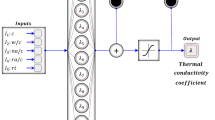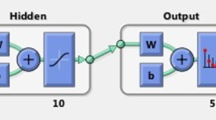Abstract
Using the discarded tire rubber as the concrete aggregate may be a solution to disposal of this waste material. However, presence of the rubber aggregates in the concrete mixture decrease the mechanical properties of such concretes depending mainly on the type and the content of the rubber used. In this paper, neural network (NN) and genetic programming (GEP) based explicit models are proposed for the prediction of mechanical properties of rubberized concretes. Data used in both training and testing of NN and GEP models were obtained from an experimental study containing a total of 70 rubberized concretes. The models were constructed using eight design variables and one response as the inputs and output, respectively. Compressive strength, splitting tensile strength, and static elastic modulus of the concretes were employed as the outputs of the models developed in this study. It is found that both NN and GEP provided high prediction capability with certain accuracy. The proposed formulations also showed perfect agreement with the experimental study, thus leading to beneficial and practical estimation of the mechanical properties of the rubberized concretes.














Similar content being viewed by others
References
Williams PT, Besler S, Taylor DT (1990) The pyrolysis of scrap automotive tyres. Fuel 69(12):1474–1482
Eldin NN, Piekarski JA (1993) Scrap tires: management and economics. J Environ Eng 119(6):1217–1232
Eldin NN, Senouci AB (1992) Use of scrap tires in road construction. J Constr Eng Manag 118(3):561–576
Sinn H, Kaminsky W, Janning J (1976) Processing of plastic waste and scrap tires into chemical raw materials, especially by pyrolysis. Angew Chem Int Ed 15(11):660–672
Farcasiu M (1993) Another use for old tires. Chemtech 23(1):22–24
Atal A, Levendis YA (1995) Comparison of the combustion behaviour of pulverized waste tyres and coal. Fuel 74(11):1570–1581
Siddique R, Naik TR (2004) Properties of concrete containing scrap-tire rubber—an overview. Waste Manag 24:563–569
Sukontasukkul P, Chaikaew C (2006) Properies of concrete pedestrian block mixed with crumb rubber. Const Build Mater 20:450–457
Eldin NN, Senouci AB (1993) Rubber tire particles as concrete aggregate. J Mater Civ Eng ASCE 5(4):478–496
Khatip ZK, Bayomy FM (1999) Rubberized Portland cement concrete. J Mater Civ Eng ASCE 11(3):206–213
Topcu IB (1995) The properties of rubberized concretes. Cem Concr Res 25(2):304–310
Benazzouk A, Douzane O, Queneudec M (2003) Effect of rubber aggregates on the physico-mechanical behavior of cement–rubber composites-influence of the alveolar texture of rubber aggregates. Cem Concr Compos 25:711–720
Güneyisi E, Gesoglu M, Özturan T (2004) Properties of rubberized concretes containing silica fume. Cem Concr Res 34(12):2309–2317
Oh JW, Lee IW, Kim JT, Lee GW (1999) Application of neural networks for proportioning of concrete mixes. ACI Mater J 96(1):61–67
Yeh IC (1998) Modeling of strength of high performance concrete using artificial neural networks. Cem Concr Res 28(12):1797–1808
Yeh I-C (1999) Design of high performance concrete mixture using neural network and nonlinear programming. J Comput Civil Eng 13(1):36–42
Hong-Guang N, Ji-Zong W (2000) Prediction of compressive strength of concrete by neural networks. Cem Concr Res 30(8):1245–1250
Lee S-C (2003) Prediction of concrete strength using artificial neural networks. Eng Struct 25(7):849–857
Dias WPS, Pooliyadda SP (2001) Neural networks for predicting properties of concretes with admixtures. Constr Build Mater 15(8):371–379
Goh ATC (1995) Prediction of ultimate shear strength of deep beams using neural networks. ACI Struct J 92(1):28–32
Sanad A, Saka MP (2001) Prediction of ultimate shear strength of reinforced concrete deep beams using neural networks. J Struct Eng ASCE 127(7):818–828
Sakla SSS, Ashour AF (2005) Prediction of tensile capacity of single adhesive anchors using neural networks. Comput Struct 83:1792–1803
Alqedra MA, Ashour AF (2005) Prediction of shear capacity of single anchors located near a concrete edge using neural networks. Comput Struct 83:2495–2502
Gesoglu M, Guneyisi E (2007) Prediction of load-carrying capacity of adhesive anchors by soft computing techniques. Mater Struct 40:939–951
Baykasoglu A, Dereli T, Tanıs S (2004) Prediction of cement strength using soft computing techniques. Cem Concr Res 34:2083–2090
Yang Y, Soh CK (2002) Automated optimum design of structures using genetic programming. Comput Struct 80:1537–1546
Ashour AF, Alvarez LF, Toropov VV (2003) Empirical modeling of shear strength RC deep beams by genetic programming. Comput Struct 81:331–338
Zadeh LA (1994) Soft computing and fuzzy logic. IEEE Softw 11(6):48–56
Alexhander I, Morton H (1993) Neurons and symbols: the staff that mind is made of. Chapman and Hall, London
Arbib MA (1995) The handbook of Brain theory and neural networks. MIT Press, Cambridge, MA
Anderson JA (1995) An introduction to neural networks. A Bradford book. MIT Press, Cambridge, MA
Birinci F, Tigdemir M, Demir F (2001) Prediction of concrete compressive strength using artificial neural Networks. In: Proceedings of the symposium on modern methods, Istanbul, pp 161–169
Uchimura S, Hamamoto Y, Tomita S (1995) Effects of the sample size in artificial neural network classifier design. IEEE 3:2126–2129
Wang D (1993) Neural networks in perspective. Pattern recognition. IEEE Expert 3:52–60
Nielsen DH (1988) Neurocomputing: picking the human brain. IEEE Spectr 25(3):36–41
Kohonen T (1988) An introduction to neural computing. Neural Netw 1:3–16
Al-Tabtabai H, Alex PA (1999) Using genetic algorithm to solve optimization problems in construction. Eng Constr Archit Manag 6(2):121–132
Ferreira C (2006) Gene expression programming: mathematical modeling by an artificial intelligence (Studies in computation intelligence). Springer, Berlin, Heidelberg
Goldberg D (1989) Genetic Algorithms in search, optimization and machine learning. Addison-Wesley, Reading, MA
Miles JC, Sisk GM, Moore CJ (2001) The conceptual design of commercial buildings using a genetic algorithm. Comput Struct 79:1583–1592
Chang WT, Hao H (2001) An application of genetic algorithm to precast production scheduling. Comput Struct 79:1605–1616
Hagan MT, Demuth HB, Beale MH (1996) Neural network design. PWS Publishing Company, Boston, MA
Ferreira C (2001) Gene expression programming: a new adaptive algorithm for solving problems. Complex Syst 13(2):87–129
Author information
Authors and Affiliations
Corresponding author
Rights and permissions
About this article
Cite this article
Gesoğlu, M., Güneyisi, E., Özturan, T. et al. Modeling the mechanical properties of rubberized concretes by neural network and genetic programming. Mater Struct 43, 31–45 (2010). https://doi.org/10.1617/s11527-009-9468-0
Received:
Accepted:
Published:
Issue Date:
DOI: https://doi.org/10.1617/s11527-009-9468-0




